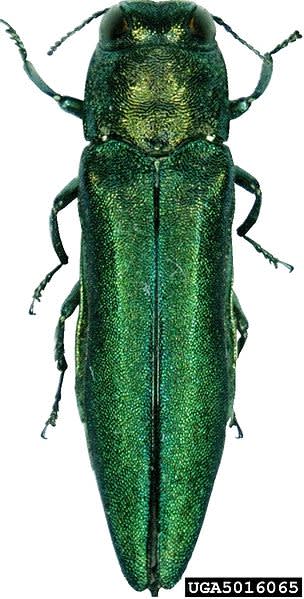Emerald Ash Borers Found Spread Further East Than Ever Before
OutdoorHub 04.22.12

The discovery of the Emerald Ash Borer (EAB) has been confirmed by the USDA Animal Plant Health Inspection Service (APHIS) in Dutchess County directly across the Hudson River from the large infestation found two years ago in the City of Kingston and its vicinity, the New York State Department of Environment Conservation announced today. This marks the first discovery of EAB east of the Hudson River.
“Because of the threat Emerald Ash Borer poses to New York’s ash trees, DEC is committed to our Slow Ash Mortality initiative designed to monitor and decelerate the spread of this damaging pest,” said DEC Commissioner Martens. “This new discovery confirms that DEC’s early detection tactics for the insect are working and enables us to respond quickly before EAB is firmly established in Dutchess County.”
The EAB is a small but destructive beetle that infests and kills North American ash tree species, including green, white, black, and blue ash. DEC adopted a strategy, Slow Ash Mortality (SLAM), to slow the spread of EAB within the state and its devastating economic and environmental impacts. SLAM encompasses a variety of approaches to address EAB infestations including removing infested trees, defining and monitoring infestation boundaries more precisely and researching insecticides and organisms that kill pests.
This latest detection of EAB is the first on the east side of the Hudson River. On March 8, several larvae of the invasive insect were discovered in “detection trees” by DEC and the US Forest Service staff. Last summer, DEC staff created numerous detection trees across the state in areas that are high risk to new EAB introductions. These trees were created by girdling, or stripping away a section of the bark around the trunks of ash trees.
Girdling eventually kills the trees, but before they die, the trees produce extra chemical volatiles which attract emerald ash borer females to lay their eggs in the bark. The detection trees are cut down and sampled, where the bark is peeled to look for signs of EAB larvae over the following winter when the bugs are not active. Approximately 28 ash trees were girdled last spring in Dutchess County because of its proximity to the known EAB infestation.
As part of SLAM, DEC and the U.S. Forest Service conducted further surveillance of the area last week to determine the extent of the new infestation, collecting samples from 75 ash trees and conducting visual inspections around the area looking for additional signs of possible EAB attack. In addition, approximately 110 additional ash trees were girdled at the sampling locations to attract any EAB present in the area from flying farther away to other ash trees. The girdled trees will be felled and peeled this fall after the conclusion of the flight season to evaluate their effectiveness.
The survey included sample points beginning from each of the three infested trap trees outward for approximately three miles. No additional EAB larvae were observed in the trees that were sampled.
Damage from EAB is caused by the larvae, which feed in tunnels just below the ash tree’s bark. The tunnels disrupt water and nutrient transport, causing branches and eventually the entire tree to die. Adult beetles leave distinctive D-shaped exit holes in the outer bark of the branches and the trunk. Other signs of infestation include tree canopy dieback, yellowing and extensive sprouting from the roots and trunk. Infested trees may also exhibit woodpecker damage from larvae extraction.
The first detection of EAB in New York was in the town of Randolph, Cattaraugus County, in June 2009. Since then, infestations were later discovered in five more counties in Western New York and four in the Hudson Valley. Nineteen counties in NY are under state and federal EAB quarantines.
Since it was first discovered in Michigan in 2002, EAB has been responsible for the destruction of 70 million trees in the United States. New York has more than 900 million ash trees, representing about seven percent of all trees in the state, and all are at risk from EAB. Communities face particular risks as ash is a common street and park tree, and green ash, in particular, has been widely planted as an ornamental tree in yards. Recent research papers have reported that the potential costs to municipalities from EAB could exceed $12 billion over the next 10 years. Efforts like DEC’s SLAM initiative can significantly delay the loss of ash trees and the subsequent costs to communities for their removal and replacement.
In 2008, New York adopted regulations that ban untreated firewood from entering the state and restricts intrastate movement of untreated firewood to no more than a 50-mile radius from its source. This was done as a precaution against the introduction and spread of EAB and other invasive species because of the documented risk of transmission by moving firewood. After more than three years of outreach and education efforts about the risks of moving firewood and the state’s regulation, DEC is increasing its enforcement efforts to prevent the movement of untreated firewood into and around New York.
DEC urges residents to watch for signs of infestation in ash trees. To learn more about Emerald Ash Borer and the firewood regulations, or to report suspected EAB damage, call DEC’s emerald ash borer hotline at 1-866-640-0652 or submit an EAB report on the DEC Web site.

